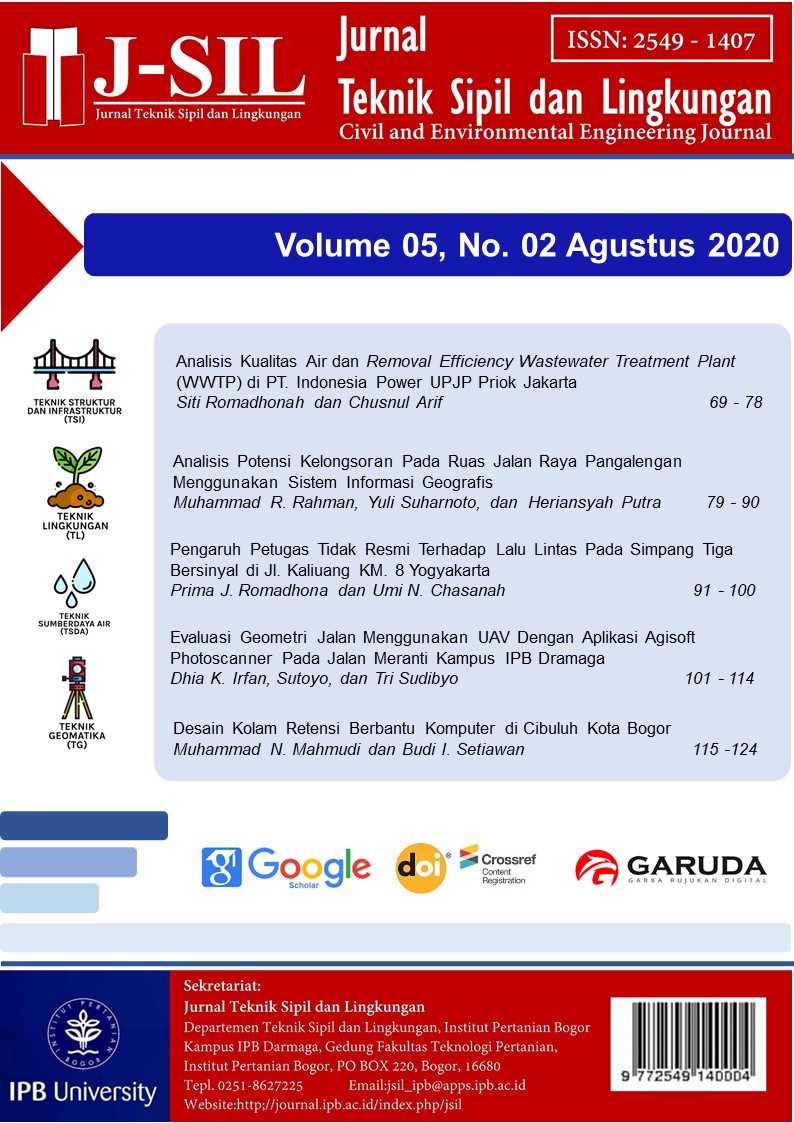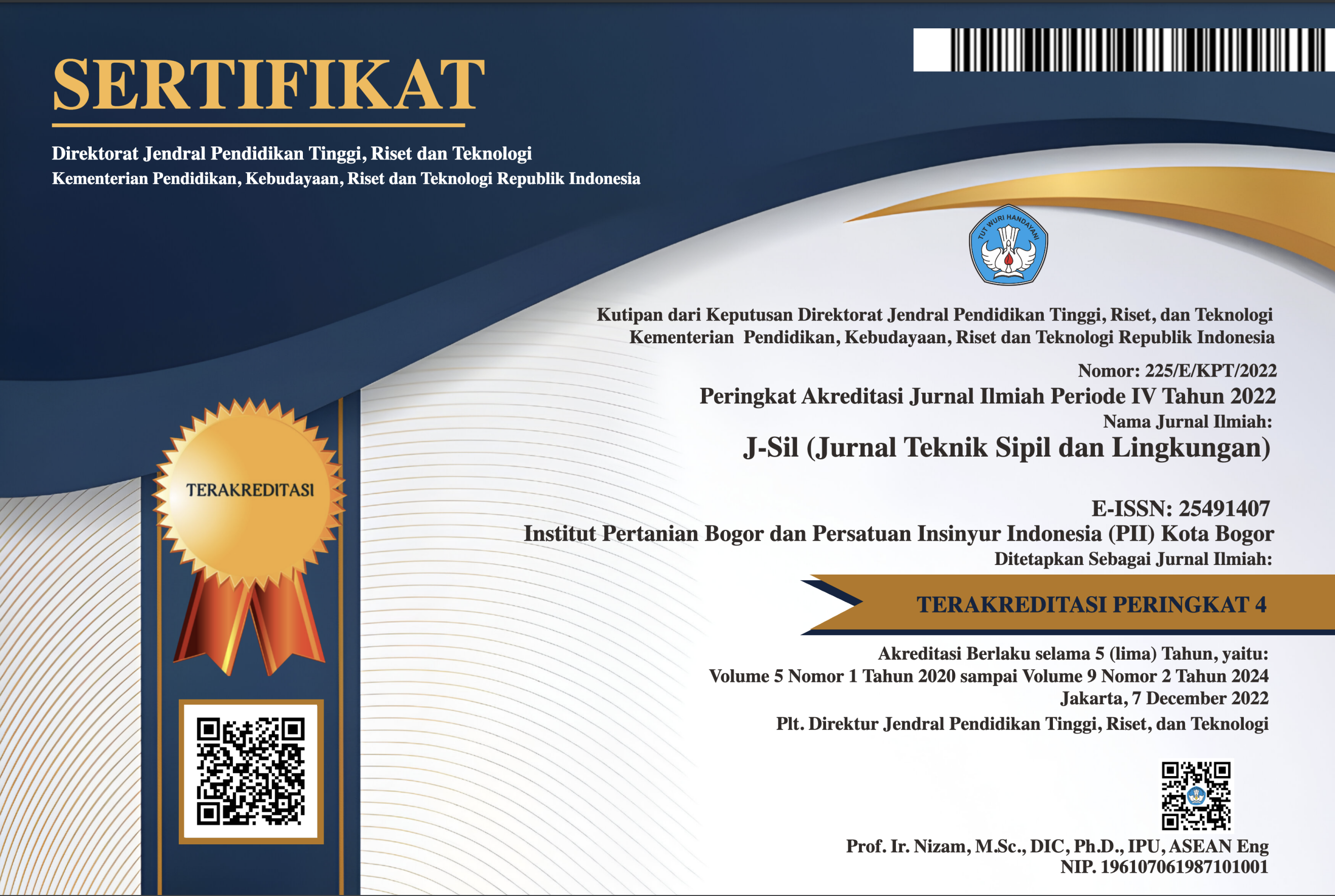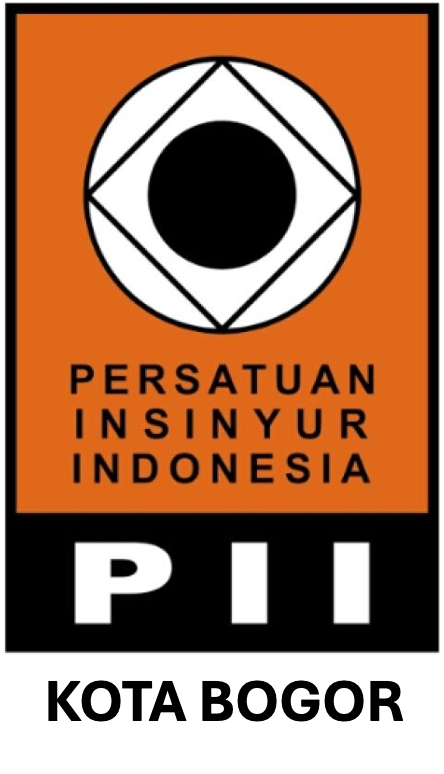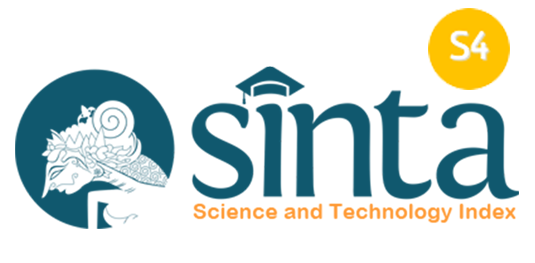Pengaruh Petugas Tidak Resmi Terhadap Lalu Lintas Pada Simpang Tiga Bersinyal di Jl. Kaliurang KM.8 Yogyakarta
Abstract
The congestion at the PLN intersection Kaliurang street Km 8 is the reason of Unofficial Officers or so-called "Pak Ogah" act as traffic regulators or assist in the movement of driving from minor roads to major roads. Therefore, the objective of the study was to determine the impact of Unofficial Officers on the performance of intersections. The survey was conducted for 3 days which were volume survey, a survey of vehicle speed, driving behavior, and length of the queue. VISSIM modeling analysis results showed that using signals was better than existing conditions with a decrease in the average delay value of 18.44% and a decrease in the average queue length of 80.34%. Meanwhile, the condition of intersections with unofficial officers decreased by an average delay of 22.10% compared to existing conditions. However, the average queued length by unofficial officers increased by 22.54% compared to existing conditions. Although the results of delays with Unofficial Officers were better than other conditions, arrangements by unofficial officers had many conflicts, creating the risk of accidents at the intersection.
Downloads
References
Alhadar, A. (2011), Analisis Kinerja Jalan Dalam Upaya Mengatasi Kemacetan Lalu Lintas Pada Ruas Simpang Bersinyal Di Kota Palu, Jurnal SMARTe, vol. 9, no. 4, pp 327 – 336. Palu.
Antony, N.D. (2019), Peneliti Transportasi Unhas Jelaskan Sebab Pak Ogah Buat Macet Makassar, detikNews, diakses 16 Februari https://m.detik.com/news/berita/d-4821889/peneliti-transportasi-unhas-jelaskan-sebab-pak-ogah-buat-macet-makassar.
Antony, N.D. (2020), Pak Ogah Buat Macet Makassar Ketua DPRD: Dishub Stand By Di Jalan. detikNews, diakses 16 Februari, https://news.detik.com/berita/d-4899099/pak-ogah-buat-macet-makassar-ketua-dprd-dishub-stand-by-di-jalan?_ga=2.30657535.1167882986.1581812864-663432020.1581812864).
Arisandi, Y. (2015), Analisis Kinerja Simpang Tak Bersinyal Di Kota Malang (Studi Kasus Simpang Pada Ruas Jl. Basuki Rahmat Kota Malang), Jurnal Penelitian Transportasi Darat. vol. 17, no 2, pp 111-118. Jakarta.
Aryandi, R.D. dan Munawar A. (2014), Penggunaan Software Vissim Untuk Analisis Simpang Bersinyal: Studi Kasus Simpang Mirota Kampus Terban Yogyakarta. 17th FSTPT International Symposium, 22–24 Agustus. Universitas Jember. Jember.
Direktorat Jenderal Bina Marga (1997), Manual Kapasitas Jalan Indonesia (MKJI), Penerbit Departemen Pekerjaan Umum. Jakarta.
Direktorat Jenderal Perhubungan Darat (1996), Buku Menuju Tertib Lalu Lintas Dan Angkutan Jalan Yang Tertib. Jakarta.
Kulo, E.P. dkk. (2017), Analisa Kinerja Simpang Tak Bersinyal Dengan Analisa Gap Acceptance Dan MKJI 1997, Jurnal Sipil Statik, vol.5, no.2, pp 2337-6732. Manado.
Morlok, E.K. (1988), Pengantar Teknik dan Perencanaan Transportasi, Erlangga. Jakarta.
Nursalam dan Akhir, M. (2016), Persepsi Masyarakat Terhadap Eksistensi Pak Ogah. Jurnal Equilibrium Pendidikan Sosiologi, vol. III, no. 2, pp 224. Makassar.
Pemerintah Republik Indonesia (2015), Peraturan Menteri Nomor 96 Tahun 2015 tentang Pedoman Pelaksanaan Kegiatan Manajemen dan Rekayasa Lalu Lintas. Sekretariat Negara. Jakarta.
Pemerintah Republik Indonesia (2009). Undang - Undang Nomor 22 Tahun 2009 tentang Lalu Lintas dan Angkutan Jalan. Sekretariat Negara. Jakarta.
Romadhona, P.J. dan Yuliansyah, A. (2018), Perbandingan Kinerja Simpang dengan Pengaturan Petugas Tidak Resmi, Tanpa Pengaturan, dan Pengaturan Sinyal (Studi Kasus Simpang Kronggahan Sleman), Jurnal Potensi Politeknik Negri Bandung. Bandung
Saputro, T.L. dkk. (2018), Kajian Simpang Tiga Tak Bersinyal Kariangau KM. 5,5 Kelurahan Karang Joang Balikpapan Utara Menggunakan Permodelan VISSIM menjadi Simpang Bersinyal, Jurnal Teknologi Terpadu, vol. 6, no. 1, pp 2338 – 6649. Balikpapan Utara.
Sugiharti, P. dan Widodo, W. (2013), Analisis Kinerja Simpang Tak Bersinyal (Studi Kasus: Simpang 3 Tak Bersinyal Jl. Raya Seturan-Jl. Raya Babarsari-Jl. Kledokan, Depok, Sleman, Yogyakarta), Konferensi Nasional Teknik Sipil 7. Surakarta.
Tahjudin, I. (2017). Pemodelan Simpang Tak Bersinyal Menjadi Simpang Bersinyal Menggunakan Software Vissim. Tugas Akhir. (Tidak Diterbitkan). Universitas Muhammadiyah Yogyakarta. Yogyakarta.
Tirtana, G.A. (2012), Pak Ogah Ibarat Buah Simalakama, Radar Jogja, diakses 16 Februari 2020, https://radarjogja.jawapos.com/2018/12/26/pak-ogah-ibarat-buah-simalakama/.
Utama, D. (2006), Evaluasi Kinerja Simpang Tak Bersinyal Antara Jalan Sultan Hamengkubuwono 9 Dan Jalan Cakung Cilincing Raya, Jurnal Sains dan Teknologi Indonesia, vol.8, no.2, pp 75-80. Jakarta.
Verawanti dan Romadhona, P.J. (2019), Dampak Petugas Pengatur Lalu Lintas Terhadap Kinerja Simpang 4 Tak Bersinyal Jalan Agro – Bougenvile (Lembah UGM) Yogyakarta, Jurnal Teknisia Universitas Islam Indonesia. Yogyakarta.
Wardhana, W.R.S dan Hartantyo D.S. (2016), Analisa Persimpangan Tak Bersinyal Pada Persimpangan Tiga Lengan, Jurnal CIVILLa, vol.1, no.2, pp 2503-2399.
YUD, 2018, Dishub: 2019, Bekasi Bebas "Pak Ogah", Berita Satu, Diakses 16 Februari 2020, https://www.beritasatu.com/megapolitan/473844/dishub-2019-bekasi-bebas-pak-ogah.
Copyright (c) 2020 Jurnal Teknik Sipil dan Lingkungan

This work is licensed under a Creative Commons Attribution-NonCommercial-NoDerivatives 4.0 International License.
Authors who publish with Jurnal Teknik Sipil dan Lingkungan, JSIL agree to the following terms:
a. Authors retain copyright and grant the journal right of first publication with the work simultaneously licensed under a Creative Commons Attribution License that allows others to share the work with an acknowledgment of the work's authorship and initial publication in this journal.
b. Authors are able to enter into separate, additional contractual arrangements for the non-exclusive distribution of the journal's published version of the work (e.g., post it to an institutional repository or publish it in a book), with an acknowledgment of its initial publication in this journal.
c. Authors are permitted and encouraged to post their work online (e.g., in institutional repositories or on their website) prior to and during the submission process, as it can lead to productive exchanges, as well as earlier and greater citation of published work (See The Effect of Open Access).











